PREVIOUS
National Family Health Survey 2019-21 on Tamilnadu (NFHS-5) - Part 02
National Family Health Survey 2019-21 on Tamilnadu (NFHS-5) - Part 02
(இதன் தமிழ் வடிவத்திற்கு இங்கே சொடுக்கவும்)
Life Expectancy
- Life expectancy at birth has also improved, rising from 68.9 years (2006-10) to 72.1 years (2014-18).
- It is above the national average of 69.4 years.
Sex Ratio at Birth (SRB)
- According to the NFHS 5 report, several districts reported varying levels of Sex Ratio at Birth (SRB).
- Nagapattinam, Ramanathapuram, Thoothukkudi, Vellore, and Virudhunagar districts had low SRBs, ranging from 722 to 799.
- In contrast, Dharmapuri, Namakkal, Sivaganga, The Nilgiris, and Theni districts reported high SRBs, ranging from 1035 to 1130.
Full Vaccination Coverage and Child Health
Vaccination Coverage
- Full vaccination coverage for children between 12 to 23 months of age has improved significantly, rising from 76.1% according to NFHS 4 to 90.4% in NFHS 5.
- This reflects a positive trend in child immunization efforts in the state.
Breastfeeding Practices
- The proportion of children under 6 months who are exclusively breastfed has also seen an increase, growing from 48.3% in NFHS 4 to 55.1% in NFHS 5.
- This improvement is crucial for infant nutrition and health.
Childhood Anemia
- However, there has been an increase in childhood anemia among children aged 6 to 59 months, with rates rising from 50.7% to 57.4%, as reported in NFHS 5.
- This highlights an ongoing public health challenge.
Stunting Rates
- According to the NFHS 5 report, certain districts showed varying rates of stunting among children.
- Erode, Kanniyakumari, Sivaganga, Thiruvallur, and Thiruvarur districts reported relatively low stunting rates, ranging from 17.3% to 19.8%.
- In contrast, Karur, Madurai, Nagapattinam, Pudukkottai, and Tiruppur districts reported high stunting rates, ranging from 30.6% to 33.6%.
Wasting Rates
- Regarding children under-5 wasting, Coimbatore, Madurai, Pudukkottai, Ramanathapuram, Salem, and Thanjavur districts reported a low burden, with rates ranging from 7% to 10.1%.
- Conversely, Dindigul, Erode, Karur, Sivaganga, Thiruvarur, Thoothukudi, and Tiruchirappalli reported a high burden of wasting, ranging from 18.4% to 22.8%.
Family Planning
Total Fertility Rate (TFR)
- Reduced from 1.7 in 2005 to 1.6 in 2018.
Unmet Need
- Total unmet need in the State: 7.5%
- Unmet need for spacing: 3.0%
District Variations
- Highest total unmet need: Pudukkottai district (12.2%).
- Lowest total unmet need: Tiruppur district (4.6%).
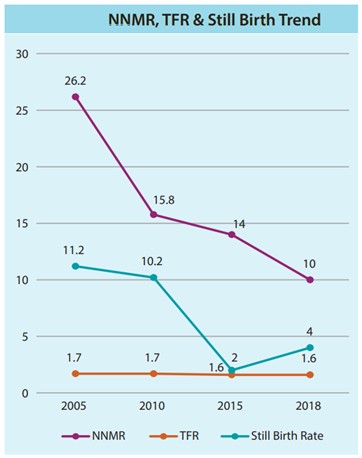
Modern Family Planning Methods
- 65.5% of married women using any modern method (NFHS 5).
- Sterilization acceptance: 57.8% females, 0.1% males.
Communicable Diseases
- Infrastructure
- 32 functional IDSP units in place.
- Disease Burden
- Communicable, maternal, neonatal, and nutritional diseases (CMNND) contribute to 17.31% of total disease burden.
- Leading Causes of Death
- Diarrheal diseases.
- Dietary iron deficiency.
- Drug-susceptible diseases.
Tuberculosis (TB)
- Annualized total case notification rate: 124
- New Smear Positive (NSP) success rate: 80
- National averages: 163% (notification), 79% (success).
National Leprosy Eradication Programs (NLEP)
- Reported prevalence rate: 0.37 per 10,000 population
- National average: 0.61
Other Diseases
- FY 2019-20: 5 deaths due to Dengue; none due to Malaria and Kala Azar.
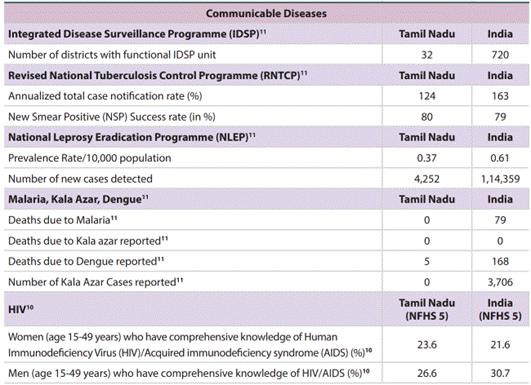
Non-Communicable Diseases (NCDs) and Injuries
Disease Burden
- 62.0% of total disease burden from premature deaths.
- 38.0% from disability or morbidity.
Major Causes of Disability Adjusted Life Years (DALYs)
- Ischaemic heart disease.
- Diabetes type 2.
- Self-harm by other means.
- Chronic Obstructive Pulmonary Disease (COPD).
Contributions to DALYs
- NCDs: 68.0%
- Injuries: 14.69%
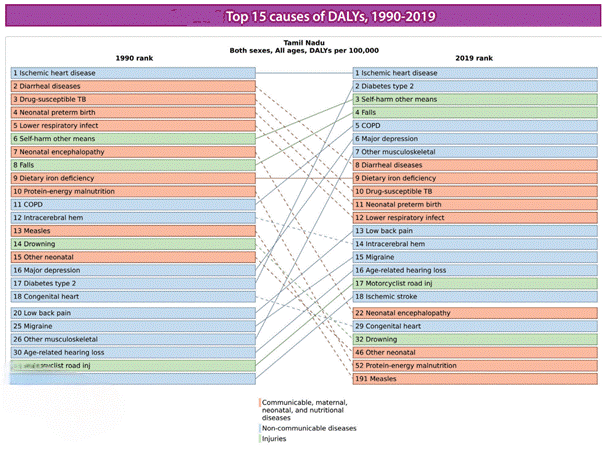
Road Accidents
- Tamil Nadu ranks 5th in fatal road accidents.
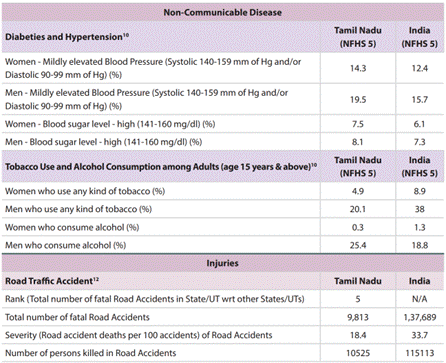
Lifestyle Factors
- Tobacco use: 4.9% women, 20.1% men.
- Alcohol consumption: 0.4% women, 29.2% men.
Major Risk Factors for DALYs and Years of Life Lost (YLLs)
- Metabolic factors: high fasting plasma glucose, high systolic blood pressure, high body-mass index, high LDL cholesterol.
- Ambient particulate matter pollution.
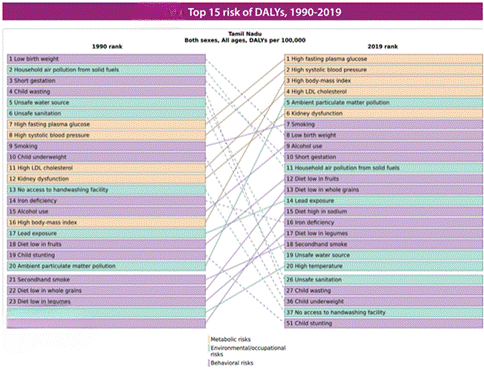
Health Care Financing
Net State Domestic Product (NSDP)
- For FY 2018-19: ₹ 14,65,361 crores.
- State ranking: 12th out of 32 states.
- Per capita NSDP: ₹ 1,93,964
Government Health Expenditure
- Per capita government health expenditure: ₹ 1,621
- National average: ₹ 1,753
Out-of-Pocket Expenditure (OOPE)
- OOPE as a share of Total Health Expenditure: 45.9%
- National average: 48.8%
OOPE for Inpatient Department (IPD) Care
Rural Areas
- Public facilities: ₹ 2,691 per hospitalized case.
- Private facilities: ₹ 30,480 per hospitalized case.
Urban Areas
- Public facilities: ₹ 2,433 per hospitalized case.
- Private facilities: ₹ 37,735 per hospitalized case.
OOPE for Childbirth
Rural Areas
- Public facilities: ₹ 3,387
- Private facilities: ₹ 35,273
Urban Areas
- Public facilities: ₹ 3,648
- Private facilities: ₹ 32,468
Expenditure on Medicines and Diagnostics
Public Health Facilities
- Share of expenditure on medicines:
- Rural areas: 27% of inpatient medical expenditure.
- Urban areas: 24% of inpatient medical expenditure.
- Share of expenditure on diagnostics:
- Rural areas: 32% of inpatient medical expenditure.
- Urban areas: 38% of inpatient medical expenditure.

Health Infrastructure
Trends in Health Facilities
- As per the recent Rural Health Statistics (RHS) data, the number of Sub Centers (SCs), Primary Health Centres (PHC), and Community Health Centres (CHC) have been increasing since 2005.
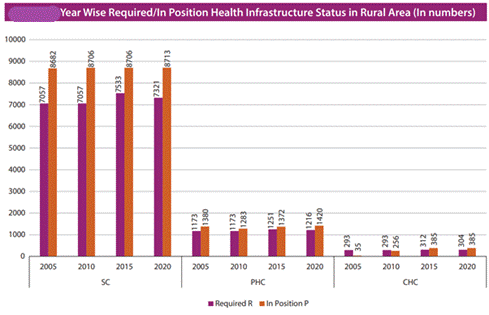
- Public health facilities have increased over time with no shortfall in the required SCs, PHCs, and CHCs.
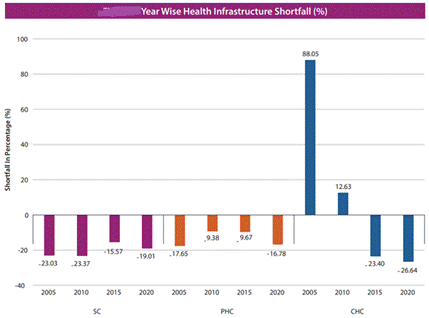
Current Facilities
- Currently, there are 8,713 SCs, 1,420 PHCs, and 385 CHCs in place, against the required 7,321 SCs, 1,216 PHCs, and 304 CHCs.
- Similarly, in urban settings, there are 464 PHCs in place against the required 800, which accounts for a shortfall of 42%.
- Tamil Nadu has 32 Divisional Hospitals (DHs), 278 Sub Divisional Hospitals (SDHs), and 26 government medical colleges.
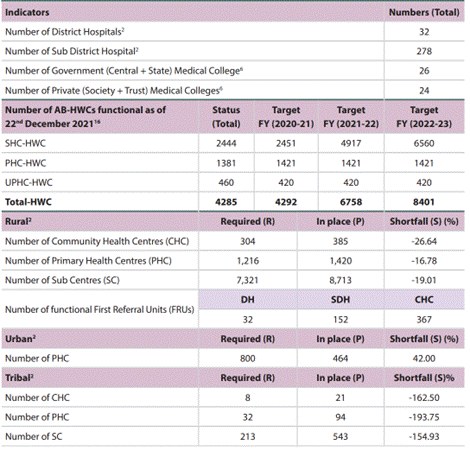
Functional Facilities
- In the State, 100% of DHs (32), 54.67% of SDHs (152), and 91.75% of CHCs (367) serve as functional First Referral Units (FRUs).
- In tribal catchments, there are 543 SCs, 94 PHCs, and 21 CHCs in place, against the required 213 SCs, 32 PHCs, and 8 CHCs.
Ayushman Bharat – Health and Wellness Centres (AB-HWCs)
- Under the recently introduced Ayushman Bharat – Health and Wellness Centres (AB-HWCs), a total of 4,285 HWCs (2,444 Sub Health Care (SHCs), 1,381 PHCs, and 460 Urban Primary Health Care (UPHCs) are operationalized in the State as of 22nd December 2021.
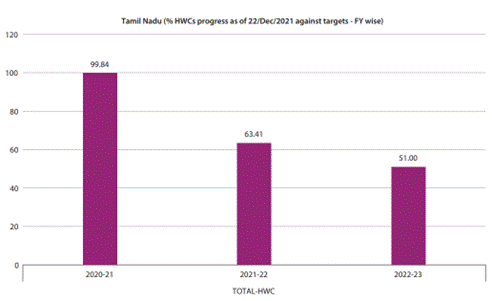
Mobile Medical Units (MMUs)
- In the State, 31 districts are equipped with MMUs under the NRHM, and none under the NUHM.
Accredited Social Health Activist (ASHA) Workers
- The State has 82% of required ASHAs in position under the NRHM and none under the NUHM.

Healthcare Provider Ratio
- The doctor to staff nurse ratio in place is 1:2, with 5 public health providers {Medical Officer (MO), specialists, staff nurse, and auxiliary nurse and midwifes (ANM)} per 10,000 population.
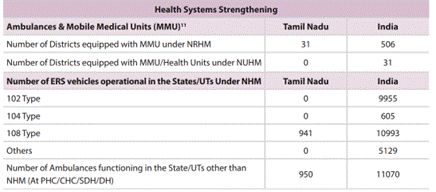
Utilization of Public Health Facilities
- The recent data reveals that out of 1,000 population who availed services from public health facilities, 3,613.03 availed (events) Outpatient department (OPD) services and 129.23 availed (events) In-patient department (IPD) services.
- As per the National Sample Survey Office (NSSO) data (2017-18), 63% of all OPD cases in rural areas and 41% in urban areas, and 57% of all IPD cases in rural areas and 42% in urban areas utilized public health facilities.
- The public health facility utilization in the State is above the national averages for both.
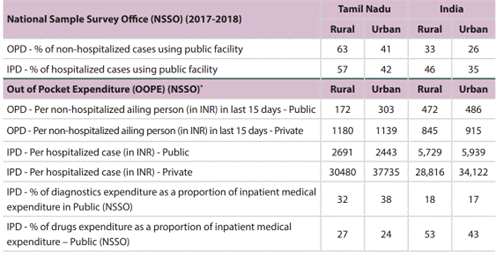
Key Findings from the National Family Health Survey (NFHS-5) in Tamil Nadu
- Tamil Nadu has demonstrated notable progress in improving maternal, child, and adolescent health outcomes.
Notable achievements include:
- Reduced maternal mortality: The state has significantly lowered its maternal mortality rate.
- Improved child health: Infant mortality rates, neonatal mortality rates, and stillbirth rates have experienced substantial declines.
- Increased immunization coverage: A significantly higher proportion of children are now fully vaccinated.
- Enhanced family planning: The total fertility rate has decreased, and contraceptive use has risen.
- Increased institutional deliveries: A larger percentage of deliveries are now conducted in healthcare facilities, particularly public institutions.
However, challenges persist:
- Anaemia: Anaemia remains a prevalent public health concern among women and children.
- Stunting: Stunting rates among children exhibit geographical variations, with some districts reporting higher prevalence.
- Non-communicable diseases: NCDs constitute a significant portion of the disease burden in the state.
- Overall, Tamil Nadu's health sector has made considerable advancements, but continued efforts are necessary to address remaining challenges and ensure equitable access to healthcare services for all.
Recommendations:
- Strengthening primary healthcare: Invest in infrastructure and human resources to enhance the quality and accessibility of primary healthcare services.
- Promoting preventive healthcare: Implement programs that promote healthy lifestyles, nutrition, and disease prevention.
- Addressing anaemia: Implement interventions to reduce anaemia among women and children, such as iron supplementation and nutritional interventions.
- Addressing non-communicable diseases: Increase awareness and prevention efforts for NCDs, including lifestyle modifications and early screening.
- Ensuring equitable access: Address disparities in healthcare access and outcomes across different regions and socioeconomic groups.
- By addressing these challenges and building upon existing strengths, Tamil Nadu can further improve the health and well-being of its population.
-------------------------------------


